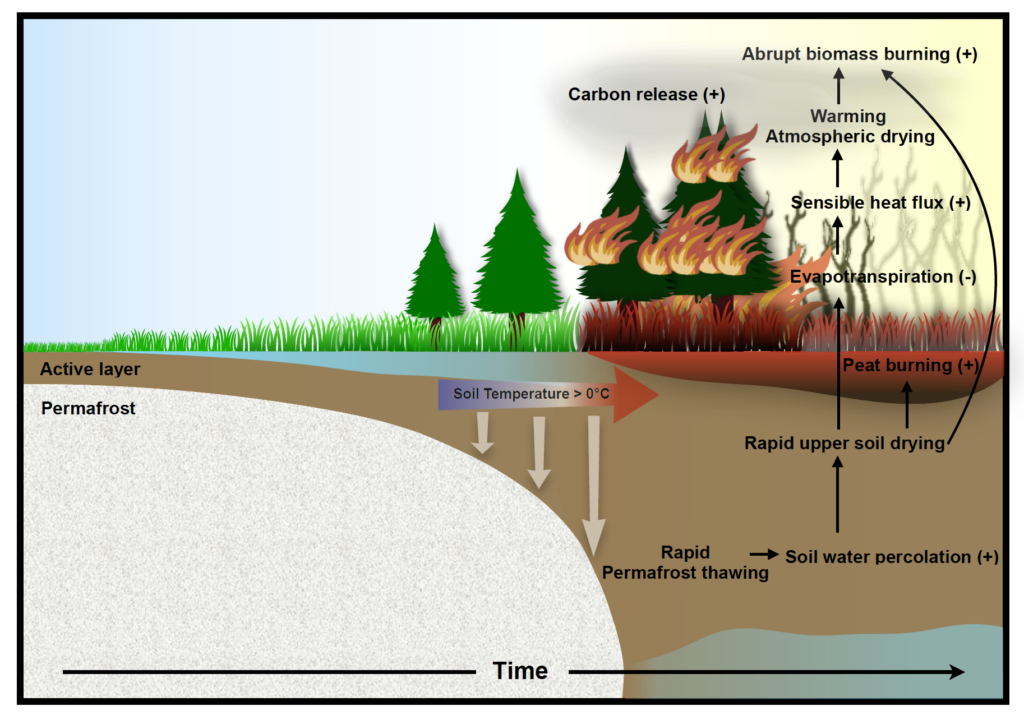A study, published in the journal Nature Communications by an international team of climate scientists and permafrost experts shows that, according to new climate computer model simulations, global warming will accelerate permafrost thawing and as a result lead to an abrupt intensification of wildfires in the Subarctic and Arctic regions of northern Canada and Siberia.
Recent observational trends suggest that warm and unusually dry conditions have already intensified wildfires in the Arctic region. To understand and simulate how future anthropogenic warming will affect wildfire occurrences, it is important to consider the role of accelerated permafrost thawing, because it strongly controls the water content of the soil – a key factor in wildfire burning. Recent climate models did not fully consider the interaction between global warming, northern high latitude permafrost thawing, soil water and fires.
The new study uses permafrost and wildfire data generated by one of the most comprehensive earth system models – the Community Earth System Model. It is the first model of its kind, which captures the coupling between soil water, permafrost and wildfires in an integrated way. To better separate the anthropogenic effect of increasing greenhouse gas emissions from naturally occurring variations in climate, the scientists used an ensemble of 50 past-to-future simulations covering the period from 1850-2100 CE (SSP3-7.0 greenhouse gas emission scenario), which was recently conducted by scientists from the IBS Center for Climate Physics, Busan (South Korea) and the National Center for Atmospheric Research in Boulder, Colorado (United States) on the IBS supercomputer Aleph.
With this ensemble modelling approach, the team demonstrated that by the mid to late 21st century anthropogenic permafrost thawing in the Subarctic and Arctic regions will be quite extensive. In many areas, the excess soil water can drain quickly, which leads to a sudden drop in soil moisture, subsequent surface warming and atmospheric drying (Figure 1). “These conditions will intensify wildfires,” says Dr. In-Won Kim, lead author of the study and postdoctoral researcher at the IBS Center for Climate Physics in Busan, South Korea. “In the second half of this century, our model simulations show an abrupt switch from virtually no fires to very intensive fires within just a few years” she adds.
These future trends will be further exacerbated by the fact that vegetation biomass is likely to increase in high latitude areas due to increasing atmospheric CO2 concentrations. This so-called CO2 fertilization effect therefore provides extra fire fuel.
“To better simulate the future degradation of the complex permafrost landscape, it is necessary to further improve small-scale hydrological processes in earth system models using extended observational datasets,” says Associate Prof. Hanna Lee, co-author of the study at the Norwegian University of Science and Technology, in Trondheim, Norway.
“Wildfires release carbon dioxide, and black and organic carbon into the atmosphere, which can affect climate and feed back to the permafrost thawing processes in the Arctic. However, interactions between fire emissions and the atmospheric processes have not been fully integrated into earth system computer models yet. Further consideration of this aspect would be the next step,” says Prof. Axel Timmermann, co-author of the study and director of the ICCP and Distinguished Professor at Pusan National University.

Notes for editors
– References
Abrupt increase in Arctic-Subarctic wildfires caused by future permafrost thaw (2024) In-Won Kim, Axel Timmermann, Ji-Eun Kim, Keith B. Rodgers, Sun-Seon Lee, Hanna Lee, and William R. Wieder, Nature Communications, vol. 15, article 7868, DOI: 10.1038/s41467-024-51471-x
– Media Contact
For further information or to request media assistance, please contact: U-Jeong Seo, IBS Center for Climate Physics, Pusan National University (+82-51-510-7328, u_jeongs@pusan.ac.kr)
– About the Institute for Basic Science (IBS)
IBS was founded in 2011 by the government of the Republic of Korea with the sole purpose of driving forward the development of basic science in South Korea. IBS has 34 research centers.
– About ICCP
The IBS Center for Climate Physics (ICCP) expands the frontiers of earth system science by conducting cutting-edge research into climate dynamics and utilizing high-performance computer simulations to elucidate how climate has shaped human history and to improve decadal Earth system forecasts and long-term climate, sea-level and biogeochemical projections. See more on http://ibsclimate.org.